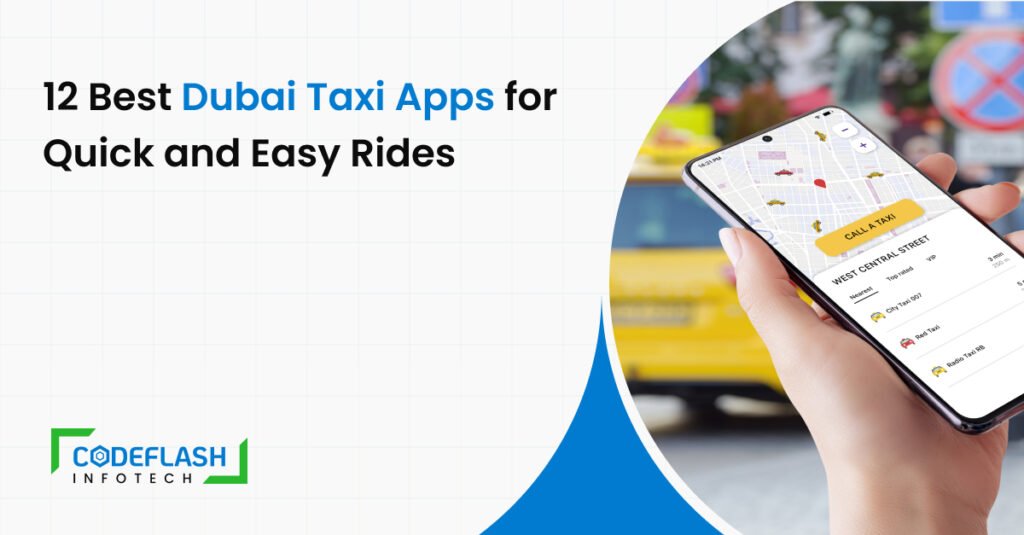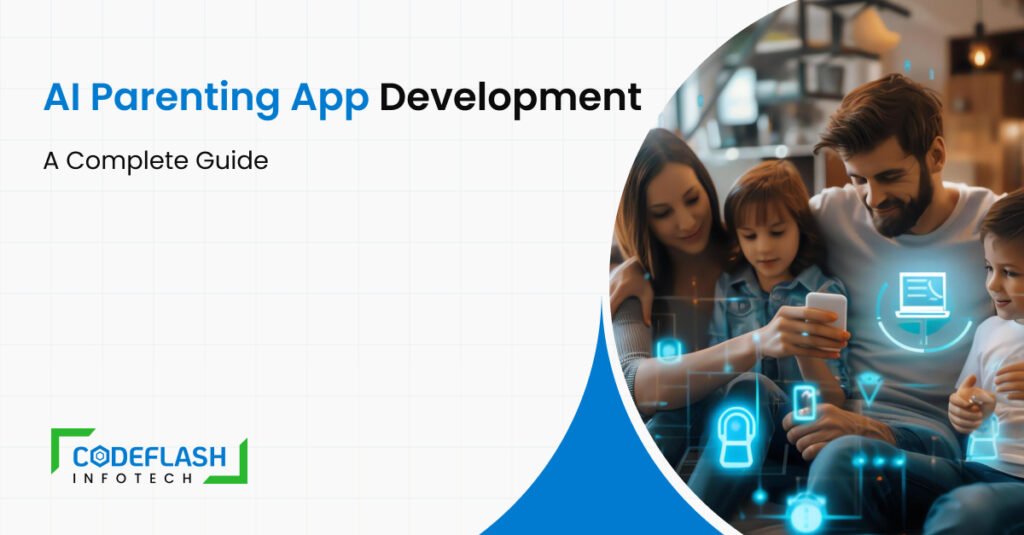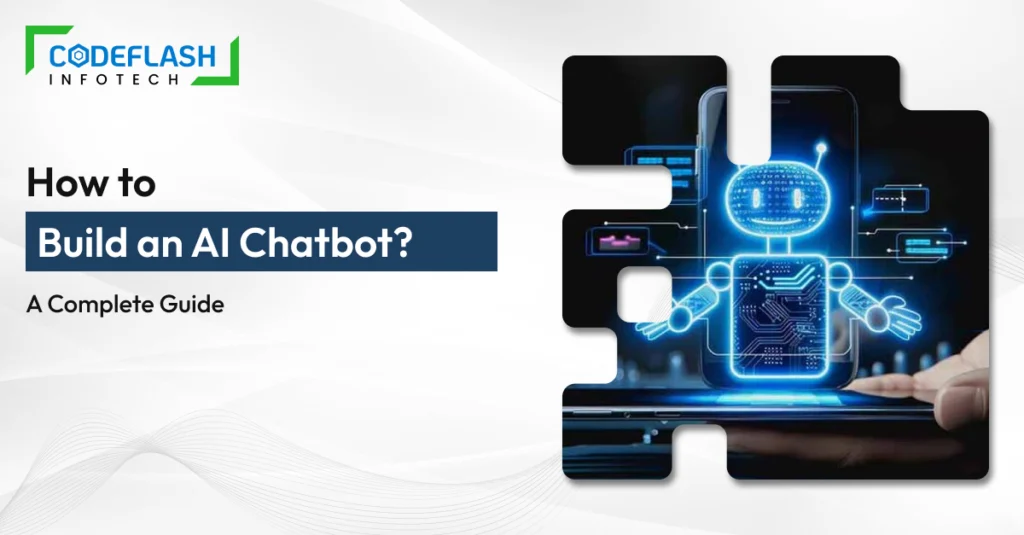
How to Build an AI Chatbot? A Complete Guide
08 AUGUST
AI chatbots are no longer futuristic extras; they’re a vital part of AI in mobile app development, offering smarter interactions, faster support, and intelligent insights. They’re a vital part of AI in mobile app development, offering smarter interactions, faster support, and intelligent insights. They are now essential tools that enhance customer engagement, automate support, and provide valuable insights. CEOs, CTOs, and company owners can gain a real competitive edge, achieve faster response times, and generate more intelligent leads by implementing an AI-powered chatbot.
According to Statista, 82% of consumers prefer to use a chatbot over waiting for a human agent when they have simple questions. Investing in AI chatbot development is not only wise but also necessary, as the chatbot and conversational AI markets are expected to grow significantly between 2025 and 2029.
From initial planning and tool selection to NLP chatbot development, this AI chatbot development guide will walk you through every step of how to build a chatbot with NLP and AI
Whether you are managing enterprise-level deployments or testing prototypes, you will gain practical, strategic insights to launch a Conversational AI chatbot solution with a high impact.
What is an AI chatbot?
Build an AI Chatbot to transform the way your business communicates. An artificial intelligence chatbot is advanced software that understands, interprets, and responds to human conversations via text or voice using natural language processing (NLP) and artificial intelligence.
When you build an AI chatbot, you create a system that can handle complex queries, learn from interactions, and engage in more organic, dynamic conversations compared to traditional rule-based chatbots that rely solely on pre-written scripts.
Businesses across industries build AI chatbots for multiple purposes — from customer service and appointment scheduling to lead generation and product recommendations. By choosing to build an AI chatbot, companies can automate repetitive tasks, reduce manual labor, and ensure instant responses, minimizing human effort while enhancing customer experience.
You can build an AI chatbot for websites, mobile apps, or messaging platforms, making it accessible to users anytime, anywhere. Incorporating this into your digital transformation strategy is essential, as modern chatbots leverage conversational AI, deep learning for training, and real-time data analysis to simulate human interactions and continuously assist users.
If you’re ready to build an AI chatbot that improves efficiency, boosts engagement, and scales with your business, the time to start is now.
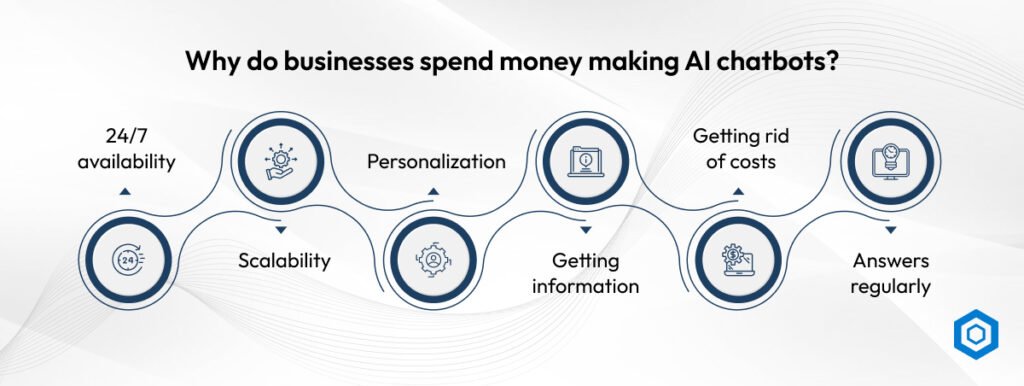
Why do businesses spend money making AI chatbots?
These intelligent assistants make users more loyal and engaged by providing them with experiences that are faster, more scalable, and customized to their needs. AI chatbots can help clients with their inquiries at any time and from anywhere. Here are the benefits:
- 24/7 Availability
Artificial intelligence chatbots are available 24/7 to answer consumer questions across various time zones. This ensures that users always receive assistance, even on weekends or holidays. As a result, businesses can offer consistent support without needing a 24-hour staff.
- Scalability
AI chatbots can handle all incoming messages, regardless of the number of users, whether it’s 100 or 100,000. Support employees automatically grow to meet demand, so you don’t have to keep hiring new ones. For this reason, they are well-suited for both large companies and small businesses that are experiencing rapid growth.
- Personalization
AI chatbots utilize information about how users behave, their preferences, and past interactions to personalize conversations. People are more likely to get involved when they get answers that matter to them. By providing people with goods or services customized to their needs, personalization also boosts conversion rates.
- Getting Information
Chatbots gather information to understand human interactions and enhance services with each interaction. If businesses pay attention to recurring feedback, patterns, and problems, they can make more informed decisions. This process enhances aspects such as sales and marketing plans, customer service, and other key operational areas.
- Getting Rid Of Costs
You don’t need as many support staff anymore because AI chatbots can now do low-priority and repetitive tasks. This cuts the costs of infrastructure, labor, and training by a huge amount. These tools can help companies generate new ideas that are more valuable and discover more effective ways to assist customers.
- Answers Regularly
AI chatbots always give the same answers to common questions, but human agents may help you more or less. Consumers are more satisfied with the product, and the business adheres to its policies and brand standards. It’s also less likely that false information will spread if you talk to each other often.
Investing in chatbot development now can give businesses a significant competitive edge and ensure that their plans to engage customers effectively are successful in the future.
Read more: Why Is It Important for Your Company to Focus on User Experience and Customer Experience?
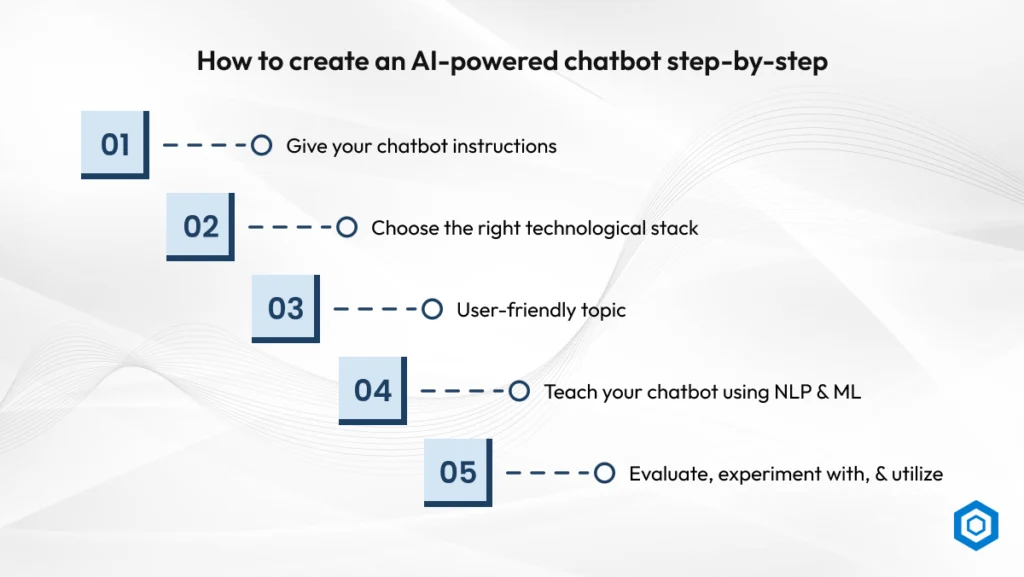
How to create an AI-powered chatbot step-by-step
While creating an AI chatbot may appear difficult, the right tools, assistance, and approach can simplify the process. Here is a step-by-step guide for businesses on how to develop an AI-powered chatbot that can help them realize their ideas:
- Give your chatbot instructions
You should know what you want your chatbot to do before you start making it. Do you want to automate customer service, qualify leads, handle orders, or get personalized recommendations?
If you know your chatbot’s primary goal, you can select the most suitable platform, training data, and conversation flows for it.
You should also consider who your bot will be interacting with and what platform they will be using, such as a website, a mobile app, or a messaging app like WhatsApp or Facebook Messenger. This influences how the bot is set up and used.
- Choose the Right technological stack.
Choose the tools and frameworks that will help your chatbot learn now that you know its purpose. Among the many popular platforms, some notable ones include Dialogflow, OpenAI, Microsoft Bot Framework, IBM Watson Assistant, and Rasa.
These platforms offer text-to-speech natural language processing (NLP), scalable infrastructure, and easy integration. You can choose between open-source and cloud-based solutions based on your apps and team’s skill level.
It’s easier to set up cloud services like AWS Lex and Google Dialogflow, but open-source technologies like Rasa allow for more customization.
- User-friendly topic
A successful chatbot not only provides answers but also facilitates natural and logical conversations between users. Think about the most common things people do on your website, like introducing themselves, asking for help, or asking about a product.
You should also write backup messages in case someone does something unexpected. Chatbot builders, flowcharts, and decision trees are all valuable tools for planning these sessions.
Make the bot’s language and tone easier for people to understand by adding small elements, such as emoticons or typing indicators. These should sound like your company.
- Teach your chatbot using NLP and ML
This occurs each time you demonstrate “intelligence” through action. Natural Language Processing (NLP) can help you teach your bot to respond to various types of questions.
You need to put in training data, which includes phrases, synonyms, and goals. The data will get better the more people you talk to. To build advanced AI chatbots that can learn and adapt independently, deep learning for chatbot training models are essential.
Frameworks like PyTorch and TensorFlow enable developers to build an AI chatbot that becomes smarter and more effective with each interaction with a user.
- Evaluate, experiment with, and utilize
Before beginning, please make sure the program comprehends your requirements, test it for bugs, and address any edge cases. Get feedback from both genuine individuals and organizations that aren’t real.
After your chatbot is up and running, utilize analytics dashboards to keep an eye on how well it’s doing. Monitor the frequency of fallbacks, their accuracy, the duration of sessions, and the number of individuals who complete them.
If a flow isn’t working, modify it and provide the bot with new information to enhance its performance.
Best tools to build AI chatbot in 2025
Choosing the right web development partner ensures your AI chatbot is scalable, reliable, and secure.Depending on your tech knowledge and what you want to do, you may need a no-code platform or a machine learning framework. In 2025, these are the best tools for making AI chatbots. Programmers claim it is simple to use and useful.
- OpenAI’s GPT model
With the ChatGPT API, developers can make intelligent bots that can write, answer tough questions, and change how they sound based on what they are doing.
- It is an excellent tool for developing chatbots capable of interacting with you.
- Pros: Customizable APIs, natural language processing, and replies that sound human are some of the benefits.
- Cons: You need strict data governance to stop hallucinations.
- The prices change based on the tokens you buy along the way.
- Google’s Dialogflow CX
Dialogflow CX is Google’s advanced cloud-based engine for processing natural language. It can read people’s emotions, making it easy to communicate with others, and it works well with other Google services. It is well-known that it is straightforward to use and useful for programmers.
- The most successful companies are those that require customer service bots capable of evolving and growing.
- It supports multiple languages, features a visual flow builder, and is easily integrated with GCP.
- This is detrimental because it costs more the more you use it.
- Microsoft Bots Framework
You can create an AI chatbot in Python, JavaScript, or C# using the open-source SDK for the Microsoft Bot Framework. It features excellent AI capabilities, including intent recognition, LUIS (Language Understanding), and bot orchestration, which work exceptionally well with Azure services.
- This offering is excellent for companies that use Azure cloud services.
- Pros: You can utilize Azure AI and take complete control of the entire development process.
- Cons: It’s more challenging for newcomers to learn.
- How much Azure you use will determine the price.
- IBM’s Watson Assistant
The Watson Assistant from IBM is a chatbot creation platform powered by artificial intelligence with a focus on privacy and security. It features voice support and advanced natural language processing, making it a suitable option.
- It is best suited for areas with regulations, such as finance and healthcare.
- Some of the benefits include its compatibility with voice, templates for specific industries, and its high security.
- The cost is more than that of other tools, which is a con.
- Price: The service offers various plan levels personalized to your usage preferences and desired features.
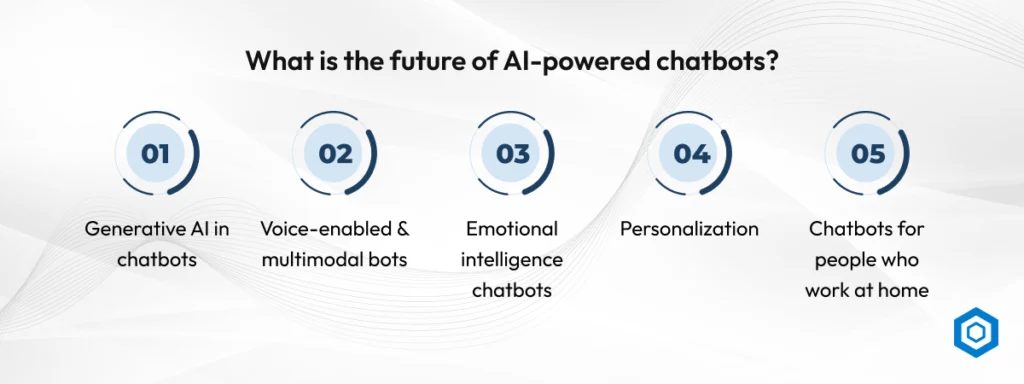
What is the future of AI-powered chatbots?
Chatbots improve as AI advances. Automating basic chores is the first step toward Conversational AI chatbot development. Here are some of the most intriguing factors that will influence the development of AI chatbots after 2025:
- Generative AI in Chatbots
Chatbots are becoming increasingly innovative, creative, and adept at answering complex questions as models like GPT-4 and others gain popularity. Generative AI has enabled bots to answer questions quickly and intelligently, much like a person would. In comparison to what they had planned to say, their response is an improvement.
Such behavior makes it more challenging to hire new staff, write content, resolve issues, and perform other tasks. It’s also more enjoyable and personal to interact with other people.
- Voice-Enabled & Multimodal Bots
Now, interfaces can do more than just show text. More and more people are using chatbots that can talk to you, especially in healthcare, smart homes, and customer service kiosks. Some more advanced bots even include text, voice, and images (like charts, pictures, and forms) to make things even easier for users.
This trend toward multimodal interfaces will make chatbots more fun, easier to use, and accessible to everyone, regardless of their age or level of experience.
- Emotional Intelligence Chatbots
Artificial intelligence (AI) systems are becoming more adept at deciphering human meaning from tone, emotions, and mood. Depending on the user’s feelings, such as anger, confusion, or happiness, these bots can alter their speech.
Individuals who possess this level of emotional intelligence are better able to understand one another, assist each other more effectively, and experience less stress.
- Personalization
In the future, AI chatbots will be able to do more than merely remember names. Additionally, they will have the ability to adjust according to users’ past website usage, preferences, and typical shopping habits.
Bots will be able to assist, remind, and recommend products before users even ask, thanks to deep learning and behavioral analytics. By providing your customers with proactive support, you can boost sales, build brand loyalty, and retain them.
- Chatbots for People Who Work at Home
Chatbots do more than just help people these days. They also assist with HR, keep employees informed about projects, train new staff, and manage the company’s IT help desks. They work together online, which makes things run more smoothly in the department and saves time.
Businesses are increasingly using Conversational AI chatbot on a daily basis, and we anticipate this trend to persist.
Read more: How to Protect Your Data Privacy
Why is Codeflash the Best AI chatbot development company?
Codeflash Infotech creates intelligent, customized AI chatbots that can benefit your company in various ways, such as increasing leads, automating processes, or assisting clients. We have extensive knowledge of real-time integration, natural language processing, and deep learning.
Your chatbot will grow and become better at talking to people. Our chatbots are effective across all platforms and domains. They also have the potential to grow alongside your company.
We manage the entire custom software development process, from initial planning to post-launch revisions. We always strive to make the UX simple, CRM-integrated, and neat. You will obtain a chatbot that can speak to you and respond to what you say and do. Reach out to us to transform your chatbot idea into a solution that will benefit your business.
Conclusion
Since its introduction as a novelty, AI chatbot development has made significant progress. Now, businesses can utilize it to attract more customers, automate customer service, and facilitate communication between them.
Deep learning and NLP are transforming the way brands communicate with their target audiences. If you stay organized, set clear objectives, use the right tools, and regularly train your chatbot, you can find a solution that resolves problems and makes memories that last a lifetime.
Regardless of the size of your company, our expert AI chatbot developers at Codeflash Infotech will ensure that your AI chatbot is practical and future-ready.

Frequently Asked Questions
The difficulty and required functions determine how long it takes to make a chatbot. While sophisticated NLP chatbot development may require 6–12 weeks, including integrations and training, a basic AI chatbot can be completed in 2–4 weeks.
Chatbots that follow the rules utilize scripts and keywords that have been pre-written to provide answers. AI chatbots can determine what people want, respond intelligently, and improve with each interaction. It uses machine learning and NLP.
You don’t need to have knowledge of how to code to make simple bots. You can use Tidio or ManyChat, which require no coding. If you want to create a custom AI chatbot that uses natural language processing or deep learning, you typically need to know how to code and work with data.



